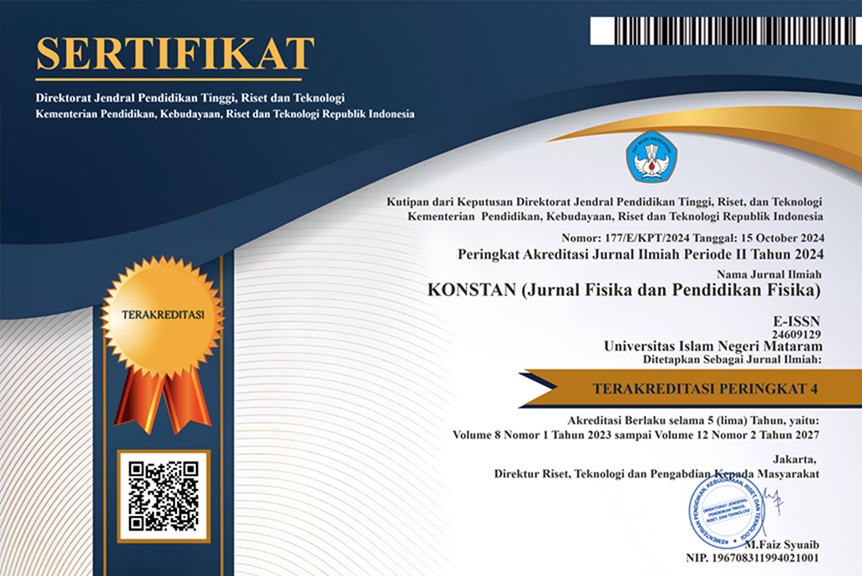Proving the Resonance of DO, RE, MI, FA, SOL, LA, SI, High DO Tones by Comparing Frequency of Sound Produced by Wine Glasses
Abstract
Due to the lack of standard laboratory facilities in many schools in Indonesia, the researcher created a simple musical instrument based on the concept of sound physics. The research was to prove the phenomenon of ‘resonance’ with the frequency comparison of the sound from ‘wine glasses’. Eight identical glasses filled with water at different heights to produce the do, re, mi, fa, sol, la, si, and do. The results showed the longer the air column, the higher the frequency of the sound produced. The sound produced by the glasses filled with less water was louder than the glasses filled with more water. This happened because of the resonance between the sound waves produced by the glasses and the sound waves propagating in the tube. Thus, it was following the theory. It could be used in the laboratory. As suggested, the researcher used tall and straight wine glasses to make it easier.
Downloads
References
[2] Fitriyani, A. O., & Andryani, F., “Analisis Akurasi Penerapan Software Audacity dalam Menentukan Nilai Frekuensi Pada Praktikum Pipa Organa,” JIPPF, 4 (1), 24-25, 2023, doi: http://dx.doi.org/10.26418/jippf.v4i1.60581
[3] Giancoli,D. C., “Fisika” 5 ed., Vol. 1, (H. H. Wibi, Penyunt., & Y. Hanum, Penerj.), Jakarta: Erlangga, 2001.
[4] Hamdani, H., “Penerapan aplikasi tone generator pada eksperimen resonansi bunyi,” Jurnal Pendidikan Informatika dan Sains, 9(1), 86-89, 2020.
[5] Nya Daniaty Malau, M. S. P., “Modul Fisika Gelombang,” 463, 2018, doi: http://repository.uki.ac.id/2645/1/Mo dulFisgel.pdf
[6] Rahmah, N., Iswadi, I., Asiah, A., Hasanuddin, H., & Syafrianti, D., “Analisis Kendala Praktikum Biologi di Sekolah Menengah Atas: (Analisis Kendala Praktek Laboratorium Biologi SMA),” BIODIK, 7(2), 169-178, 2021, doi: https://doi.org/10.22437/bio.v7i2777
[7] Sugiyanto, A., dan Sustini, E., “Kajian Fenomena Resonansi Gelombang pada Beberapa Alat Musik dan Animasinya dalam Ponsel Menggunakan Flashlite,” Vol. 1(1): 1-8, 2011.
[8] Sulanjari, S., & Wicaksana, A., “Pengaruh Panjang Dan Diameter Kolom Udara Terhadap Performa Tabung Impedansi Sebagai Alat Penentu Cepat Rambat Bunyi Di Udara,” Jurnal Teknik Mesin Cakram, 4(1), 34-38, 2021.
[9] Tipler, Paul A., “Fisika Untuk Sains dan Teknik,” Jilid 1, Jakarta: Erlangga, 1998.
[10] Wahyuningsih, D., Rampai, B., & Maret, U. S., “Fisika di sekitar kita,” 2020.
[11] Wana, W., Sulanjari, S., & Indriawati, A., “Analisis Performa Tabung Impedansi dalam Pengukuran Cepat Rambat Bunyi,” In Proceedings Of National Colloquium Research And Community Service, Vol. 4, 2020.
[12] Young, H. D., A, F. R., & L, F. A., “Universitas Physics with Modern Physics” 13 ed., Pearson Education, 2012.



